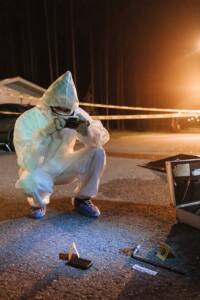Forensic Photographer

Crime scene photography or forensic photography has been around almost as long as the camera. Television has altered the way that people typically think of forensic photography featuring several crime shows with swarms of photographers appearing at the crime scene. Since the main goal of forensic photography is to capture evidence that is admissible in court, having many photographers at the scene would not be ideal. A forensic photographer must photograph everything, in case it will need to be used as evidence in court. All the photography must take place before evidence has the chance to be disturbed.
The first use of forensic photography was in the nineteenth century by Alphonse Bertillon. This makes him the first forensic photographer. It is said that Bertillon was the first to approach a crime scene like an investigator. Bertillon took various shots at the crime scene; some shots were at a distance, while others were close up. Some shots were at ground level while others were shot from overhead. Today, forensic photography is used to help prosecute a crime because the photography can capture things such as evidence that can’t physically be collected. Photos are also useful to capture evidence that possesses time restraints. For example, the shape of a bloodstain will often change over time. Forensic photography also allows investigators to see the placement of objects in relation to one other, and the placement of the objects around the room to be captured.
There are many things that a forensic photographer can photograph. A few examples include the body of the victim, shell casings, or broken glass. A forensic photographer might also be asked to photograph injuries on a victim who is alive and was attacked.
Those who are interested in forensic photography often have a good eye for detail, and take great care in their work. A forensic photographer must be methodical in their line of work. A forensic photographer can’t afford to leave out any evidence or produce photos that could be misleading. A forensic photographer must know their equipment and how it works so that when needed, special lighting can be used to create a clear image. It is also important for a forensic photographer to know scale of objects at the crime scene; this way, the objects will be represented properly and won’t be misleading.
Forensic photographers will often start out as either police officers or crime scene investigators. This way, when they do obtain a career in forensic photography, they are prepared for when they need to present evidence in court. Other forensic photographers will start in the lab to get experience and contacts so that they have a better chance of getting hired. After gaining some sort of experience, some may opt to take a forensic photography course at the college or university level. There are many different places where a forensic photographer could get hired, including the military or the arson investigation branch of the fire department.
Back to Forensic Investigation
Back to Crime Library
|
|
|

